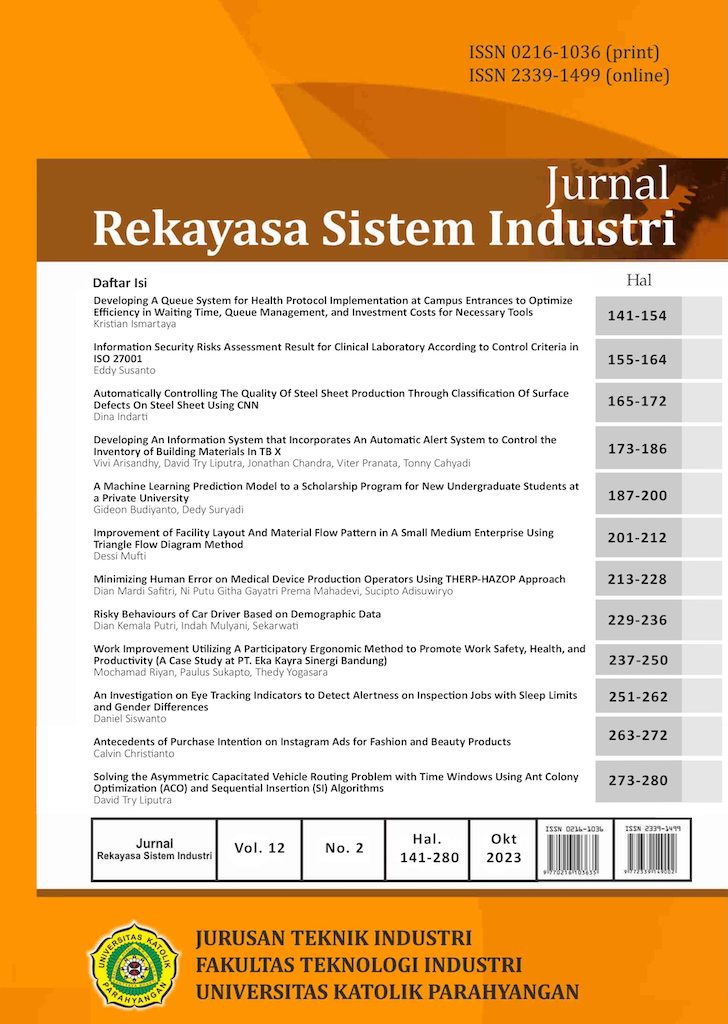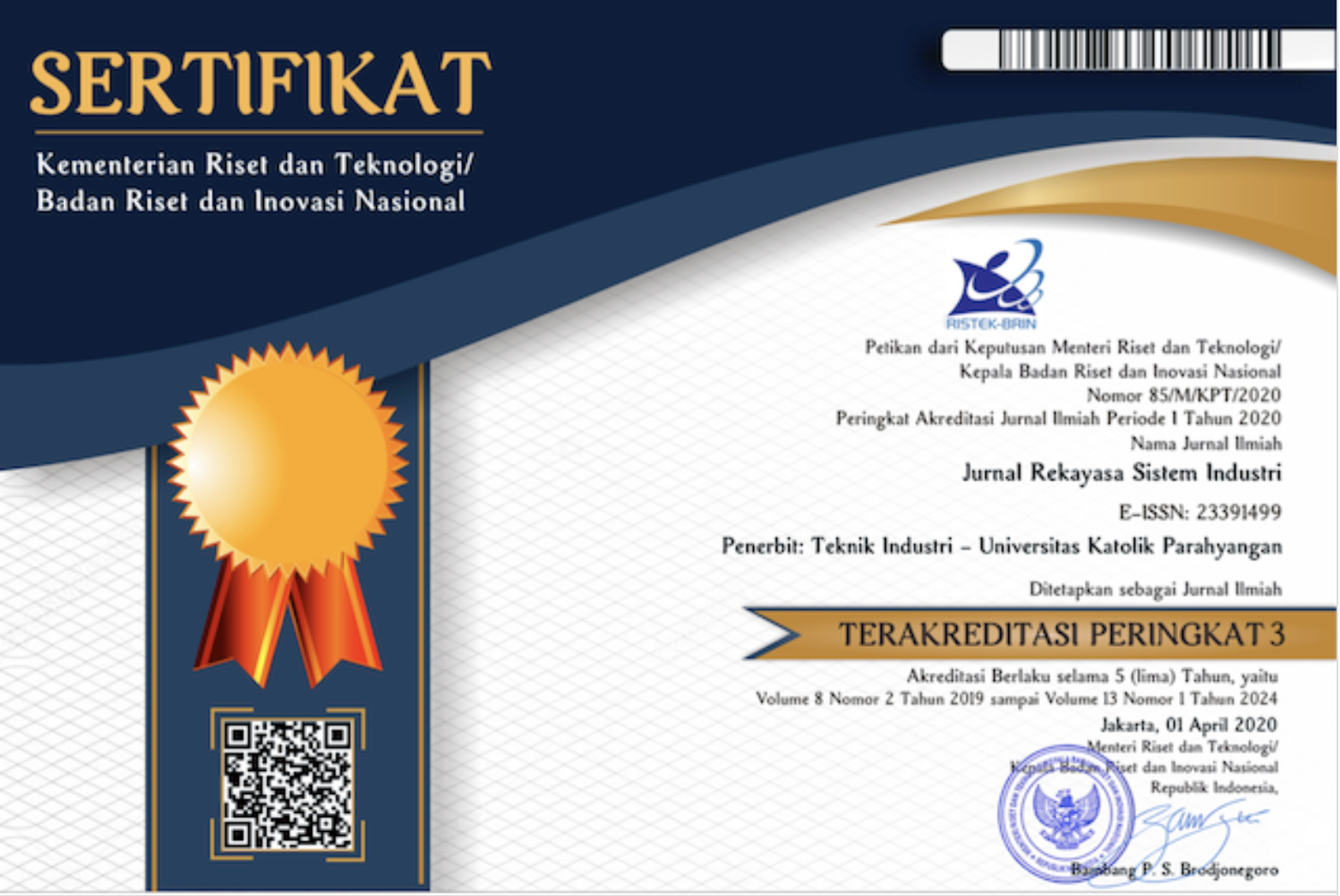Minimizing Human Error on Medical Device Production Operators Using THERP-HAZOP Approach
DOI:
https://doi.org/10.26593/jrsi.v12i2.5477.213-228Keywords:
: Human Error, Covid-19, THERP, HAZOP, human error, covid-19, THERP-HAZOPAbstract
As production quantity increases to fulfill customer’s demand, the occupational accident occurs more compared to 2020. The need to use masks increased 20.15 times more in 2021 when the Delta variant of the COVID-19 virus entered Indonesia. This research observed the Manual Welding Machine labor in their process of producing head loop masks and aimed to design mitigation strategies for high error probability tasks. Methods used in this research are the Hierarchical Task Analysis (HTA) to define operator’s tasks, the Technique for Human Error Rate Prediction (THERP) to measure HEP, Event Tree Analysis to analyze the worst possibility of an incident, and the Hazard and Operability Study (HAZOP) to collect mitigation strategy. As the result of this research, several activities such as welding process preparation, picking up materials from the container, and materials preparation process have the highest HEP among all the activities. If some errors occur, it may cause light to severe injuries to the operators and the production area near the Manual Welding work station. Several mitigation plans are recommended to handle these problems, such as using warning displays and making SOP for operating Manual Welding Machine.
References
Amin, D. S. (2019). Analisa Human Error Untuk Mengurangi Potensi Bahaya Dengan Metode THERP. Jurnal Teknik Industri.
Astuti, P., Azmi, N., Safitri, D. M., & Aryani, A. D. (2017). Analisis Human Error Pramudi Bus Transjakarta dan Usulan Rekomendasi Keselamatan Transportasi. National Conference on Industrial Engineering, 34–37.
Atmojo, J. T., Iswahyuni, S., Rejo, R., Setyorini, C., Puspitasary, K., Ernawati, H., Syujak, A. R., Nugroho, P., Putra, N. S., Nurrochim, N., Wahyudi, W., Setyawan, N., Susanti, R. F., Suwarto, S., Haidar, M., Wahyudi, W., Iswahyudi, A., Tofan, M., Bintoro, W. A., … Mubarok, A. S. (2020). Penggunaan Masker Dalam Pencegahan Dan Penanganan Covid-19: Rasionalitas, Efektivitas, Dan Isu Terkini. Avicenna : Journal of Health Research, 3(2), 84–95. https://doi.org/10.36419/avicenna.v3i2.420.
Guo, L., & Kang, J. (2015). An extended HAZOP analysis approach with dynamic fault tree. Journal of Loss Prevention in the Process Industries, 38, 224–232. https://doi.org/10.1016/j.jlp.2015.10.003.
El Hakim, A. A. (2018). Analisis Resiko Kegagalan Operasi Menggunakan Metode HAZOP Analysis Pada Onshore Pipeline PT. X (Doctoral dissertation, Institut Teknologi Sepuluh Nopember).
Kirwan, B. (1996). The validation of Three Human Reliability Quantification techniques - THERP, HEART and JHEDI: part 1- Technique description ans validation issues. Applied Ergonomics, 27(6), 359–373.
Niebel, B., & Freivalds, A. (2014). Methods, Standards, and Work Design. McGraw-Hill.
Ratriwardhani, R. A. (2018). Identifikasi Kesalahan Manusia Dengan Pendekatan Technique for Human Error Rate Prediction (Therp). Heuristic, 15(02). https://doi.org/10.30996/he.v15i02.2141.
Restuputri, Dian Palupi, R. P. D. S. (2015). Analisis Kecelakaan Kerja Dengan Menggunakan Metode Hazard and Operability Study ( Hazop ). Jurnal Ilmiah Teknik Industri, 14(1), 24–35.
Risk Assessment: Tools, Techniques, and Their Applications - ProQuest. (n.d.). Retrieved November 18, 2021, from https://www.proquest.com/docview/2131184634/bookReader?accountid=49910.
Safitri, D. M., Oktaviasari, A., Astuti, P., Azmi, N., Industri, J. T., & Trisakti, U. (2017). Analisis Human Error pada Pramudi Transjakarta dengan Pendekatan HEART dan Fault Tree Analysis. Prosiding SNTI Dan SATELIT 2017, 2017, B131-136.
Sani, C. D., Handoko, L., & Setiani, V. (2016). Analisis Human Error pada Pekerjaan Gerinda Menggunakan Metode THERP (Technique for Human Error Rate Prediction) (Studi Kasus pada Pekerja Workshop di Perusahaan Peleburan Baja ). 2581, 34–38.
Simon, F., Adhikari, S., Bayley, C., Bedford, T., Busby, J., Cliffe, A., Devgun, G., Eid, M., Keshvala, R., Pollard, S., Soane, E., Tracy, D., & Wu, S. (2009). Human Reliability Analysis: A Review and Critique. Manchester Business School Research Paper, 589. https://papers.ssrn.com/abstract=1541951.
Williamson, A. M. F. and A. M. (1998). Human Factors in Accident Modelling. Encyclopaedia of Occupational Health and Safety, Fourth Edi (Geneva: Safety International Labour Organization).
Zuhri, M. S. (2017). Mitigasi Risiko Kecelakaan Kerja Pada Packing Plant PT Semen Gresik (Persero) Tbk (Doctoral dissertation, Universitas Internasional Semen Indonesia).













